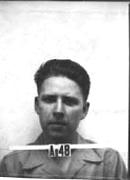Lewis Worth Seagondollar was an American physicist who worked at Los Alamos during the Manhattan Project.
Seagondollar earned his A.B. in Physics from the Kansas State Teachers College at Emporia, Kansas, in 1941. He was invited to join the Manhattan Project at Los Alamos in 1942, but his position was cancelled two hours before he was supposed to board his train due to the number of people already at Los Alamos. Seagondollar started his graduate studies in Physics at the University of Wisconsin, where he earned his master’s degree in 1943, and was offered another job at Los Alamos in 1944.
At Los Alamos, Seagondollar worked as part of a small team investigating the critical mass of plutonium—how much plutonium would be required to make a bomb. Seagondollar was also nine miles away from the Trinity test at Alamogordo on July 16, 1945. While at Los Alamos, Seagondollar’s wife Winifred worked as an administrative assistant.
After the war, Seagondollar returned to the University of Wisconsin and received his Ph.D. in Physics in 1948. He then went to the University of Kansas, where he was a professor until 1965. While in Lawrence, Seagondollar helped build the first Van de Graaff accelerator, used for research in low-energy nuclear physics. Seagondollar moved to North Carolina State University in 1965, where he was appointed the chair of the Physics Department. Seagondollar held that position for ten years, and stayed at North Carolina State University until 1991.
Dr. Worth Seagondollar died in Raleigh, North Carolina, on September 20, 2013.





